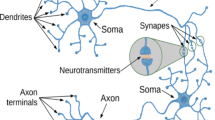Abstract
Between the extreme views concerning ontogenesis (genetic vs. environmental determination), we use a moderate approach: a somehow pre-established neuronal model network reacts to activity deviations (reflecting input to be compensated), and stabilizes itself during a complex feed-back process. Morphogenesis is based on an algorithm formalizing the compensation theory of synaptogenesis (Wolff and Wagner 1983). This algorithm is applied to randomly connected McCulloch-Pitts networks that are able to maintain oscillations of their activity patterns over time. The algorithm can lead to networks which are morphogenetically stable but preserve self-maintained oscillations in activity. This is in contrast to most of the current models of synaptogenesis and synaptic modification based on Hebbian rules of plasticity. Hebbian networks are morphogenetically unstable without additional assumptions. The effects of compensation on structural and functional properties of the networks are described. It is concluded that the compensation theory of synaptogenesis can account for the development of morphogenetically stable neuronal networks out of randomly connected networks via selective stabilization and elimination of synapses.
The logic of the compensation algorithm is based on experimental results. The present paper shows that the compensation theory can not only predict the behavior of synaptic populations (Wagner and Wolff, in preparation), but it can also describe the behavior of neurons interconnected in a network, with the resulting additional system properties. The neuronal interactions-leading to equilibrium in certain cases-are a self-organizing process in the sense that all decisions are performed on the individual cell level without knowing the overall network situation or goal.
Similar content being viewed by others
References
Beaudet A, Descarriers L (1978) The monoamine innervation of rat cerebral cortex: synaptic and nonsynaptic axon terminals. Neuroscience 3:851–860
Cotman CW, Nieto-Sampedro M, Harris EW (1981) Synapse replacement in the nervous system of adult vertebrates. Physiol Rev 61:684–784
Dammasch IE, Wagner GP (1984) On the properties of randomly connected McCulloch-Pitts networks: differences between input-constant and input-variant networks. Cybern Syst 15:91–117
Dammasch IE, Wagner GP, Wolff JR (in preparation) Self-stabilization of neuronal networks II. Stability conditions for synaptogenesis
Easton P, Gordon PE (1984) Stabilization of Hebbian neural nets by inhibitory learning. Biol Cybern 51:1–9
Eccles JC (1979) Synaptic plasticity. Naturwissenschaften 66:147–153
Flohr H (1983) Control of plastic processes. In: Basar E, Flohr H, Haken H, Mandell AJ (eds) Synergetics of the brain. Springer, Berlin Heidelberg New York Tokyo, pp 60–74
Fukushima K (1973) A model of associative memory in the brain. Kybernetik 12:58–63
Gaze RM, Keating MJ, Chung SH (1979) The orientation of the retinotectal map in Xenopus: developmental aspects. Proc R Soc Lond Ser B 185:301–330
Gierer A (1983) Model for the retino-tectal projection. Proc R Soc Lond B Ser 218:77–93
Grossberg S (1976) Adaptive pattern classification and universal recording I. Parallel development and coding of neuronal feature detectors. Biol Cybern 23:121–134
Hebb DO (1949) The organization of behavior: a neurophysiological theory Wiley, New York
Hinds JW, Hinds PL (1976) Synapse formation in the mouse olfactory bulb II. Morphogenesis. J Comp Neurol 169:41–62
Jacobson M (1978) Developmental neurobiology. Plenum Press, New York
Joó F, Dames W, Wolff JR (1979) Effect of prolonged sodium bromide administration on the fine structure of dendrites in the superior cervical ganglion of adult rat. Prog Brain Res 51:109–115
Kohonen T (1977) Associative memory. Springer, Berlin Heidelberg New York
Lee K, Oliver M, Schottler F, Creager R, Lynch G (1979) Ultrastructural effects of repetitive synaptic stimulation in the hippocampal slice preparation: a preliminary report. Exp Neurol 65:478–480
Malsburg C von der (1979) Development of ocularity domains and growth behavior of axon terminals. Biol Cybern 32:49–62
McCulloch WS, Pitts WH (1943) A logical calculus of ideas immanent in nervous activity. Bull Math Biophys 5:115–133
McGraw CF, McLaghlin BJ (1980) Fine structural studies of synaptogenesis in the superficial layers of the optic tectum. J Neurocytol 9:79–93
Nagano T, Fujiwara M (1979) A neural network model for the development of direction selectivity in the visual cortex. Biol Cybern 32:1–8
Palm G (1982) Neural assemblies: an alternative approach to artificial intelligence. Springer, Berlin Heidelberg New York
Peichl L, Bolz J (1984) Kainic acid induces sprouting of retinal neurons. Science 223:503–504
Rauschecker JP, Singer W (1981) The effects of early visual experience on the cat's visual cortex and their possible explanation by Hebb synapses. J Physiol 310:215–239
Shatz CJ, Stryker MP (1978) Ocular dominance in layer IV of the cat's visual cortex and the effect of monocular deprivation. J Physiol 281:267–283
Singer W (1983) Neuronal activity as a shaping factor in the selforganization of neuron assemblies. In: Basar E, Flohr H, Haken H, Mandell AJ (eds) Synergetics of the brain. Springer, Berlin Heidelberg New York Tokyo, pp 89–101
Wagner GP, Wolff JR (in preparation) A kinetic model of synaptogenesis based on morphogenetic consequences of excitation and inhibition
Willshaw DJ, Malsburg C von der (1976) How patterned neuronal connections can be set up by self-organization. Proc R Soc Lond Ser B 194:431–445
Willwacher G (1982) Storage of a temporal pattern sequence in a network. Biol Cybern 43:115–126
Wolff JR (1979) Indications for a dual role of GABA as a synaptic transmitter and as a morphogenetical factor. Verh Dtsch Zool Ges 72:194–200
Wolff JR (1981) Some morphogenetic aspects of the development of the central nervous system. In: Immelmann K, Barlow GW, Main M, Petrinovich L (eds) Behavioral development. The Bielefeld interdisciplinary project. Cambridge University Press, New York, pp 164–190
Wolff JR, Wagner GP (1983) Selforganization in synaptogenesis: interaction between the formation of excitatory and inhibitory synapses. In: Basar E, Flohr H, Haken H, Mandell AJ (eds) Synergetics of the brain. Springer, Berlin Heidelberg New York Tokyo, pp 50–59
Wolff JR, Joó F, Dames W, Fehér O (1979) Induction and maintenance of free postsynaptic membrane thickenings in the adult superior cervical ganglion. J Neurocytol 8:549–563
Author information
Authors and Affiliations
Rights and permissions
About this article
Cite this article
Dammasch, I.E., Wagner, G.P. & Wolff, J.R. Self-stabilization of neuronal networks. Biol. Cybern. 54, 211–222 (1986). https://doi.org/10.1007/BF00318417
Received:
Issue Date:
DOI: https://doi.org/10.1007/BF00318417




